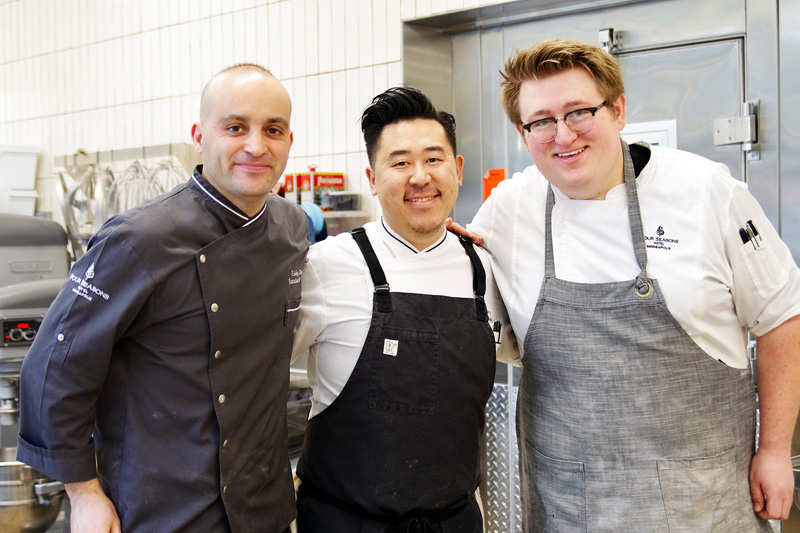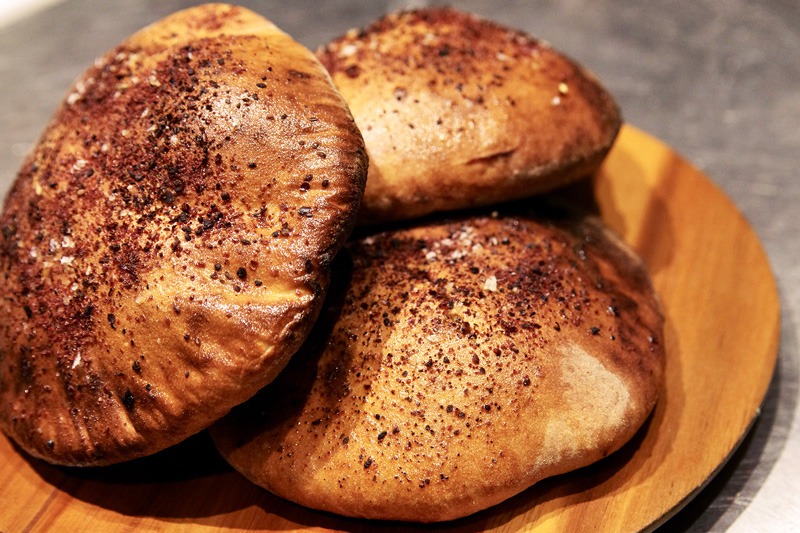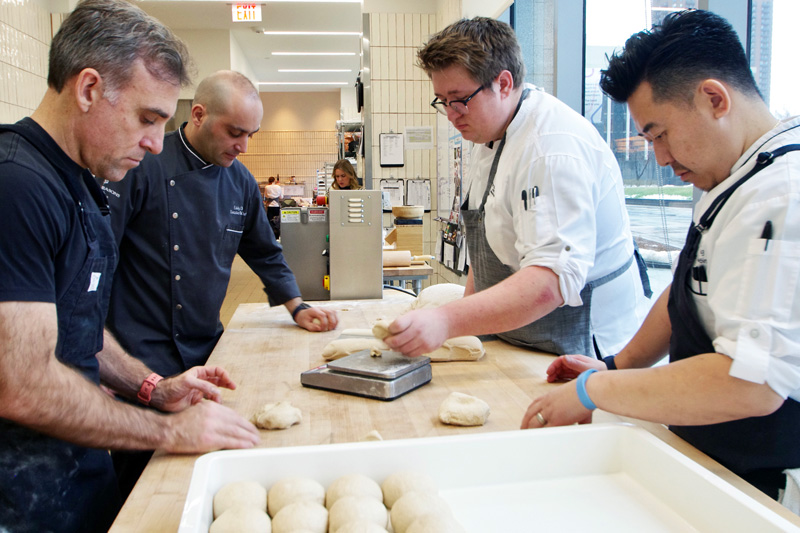PHOTOGRAPHY BY BRENDA JOHNSON
The original version of this post was provided to subscribers to the Tap newsletter, made available to our $10/month backers on Patreon. If you enjoy the work of Heavy Table’s team of writers, editors, photographers, and illustrators, please consider backing us on Patreon.
If your goal is to crank out a couple hundred whole wheat pitas a day, each one served to eager diners straight from the 700 degree deck of an oak-burning oven at the precise moment they desire, each one perfectly puffed by the rapid conversion of water to steam into a pillowy dome that stretches a 48-hour dough’s gluten structure to its absolute limits, each with a light and cracker-crisp leopard-spotted crust that gives way to a web of warm and well-developed gluten, each that will be just as satisfying torn open and smeared with hummus minutes later as it will be filled to the brim for a lunchtime eggplant caponata sandwich, then you must be the team at Mara because I don’t think anyone else in town has the talent, the resources and the drive to pull this off.

Chef de Cuisine Thony Yang (center), Executive Pastry Chef Eddy Dhenin (left) and baker James Linstrom (right) were gracious enough to recently spend some time showing-and-telling their pita process to me and I came away from the experience with a valuable glimpse into just how difficult it is to marry excellence with efficiency and volume, and just how impressive it can be when pulled off.
Why pita? Out of all the breads in all the towns in all the Mediterranean, Mara chose to highlight this one, and it makes sense on multiple levels. The concept connects a Mediterranean palate with Minneapolis’ milling history both through the industrial design of the physical space (bolts, rivets, metal) and the menu. What better way than to feature a bread that is ubiquitous in one form or another across all Mediterranean countries and to make it with locally milled grains. A bread tour of those countries reveal many different names – Khubzit Howsh, Aish Baladi, Batbout, Laffa, Khubz Arabi, Bazlama – for essentially the same thing: flour, water, yeast, salt, sugar, oil, time, a little muscle and a lot of heat. In fact, “pita” is not one bread, but instead refers to a family of flatbreads, usually leavened and usually with a pocket in which to stuff all manner of meats and veggies.

Beyond the conceptual fit, there are pragmatic benefits to this choice. First, leavened pita can serve multiple functions across a menu. Unleavened flatbreads, like the neighboring cafe’s eponymous socca, shine brightly when fresh but quickly lose their luster. A hot and crispy chickpea pancake is delightful. A cold and floppy one, less delightful. A dense and mealy next-day chickpea pancake? Seriously not delightful. Pitas are perfect for spreads right out of the oven, perfect for sandwiches once cooled, and perfect for chips days later. Second, compared to other leavened breads, pita making is a relatively straightforward and forgiving process meaning it can be consistently and promptly served to diners within the constraints of a kitchen simultaneously doing one million other things. Pita can be made with minimal proofing, with basically any flour that has reasonable protein content, and with a somewhat casual approach to the fermentation process since it’s not like the end product depends upon highly active yeast creating bubbles of CO2 to produce an impressive rise. For a totally serviceable pita, you could start mixing the dough in the early afternoon and easily be firing off fresh pockets for dinnertime.
FINELY TUNED FLATBREAD
Though this simplified process will do for just about anyone who has the desire to move beyond store-bought, this process would not do for the chefs at Mara. As Chef Thony explained, you begin constructing the baking process by understanding what you want to achieve, and the chefs are aiming much higher than a serviceable pita. They want the much more attractive and elegant sibling of the soft, white and chewy version you’ve been dating. In other words, this:

More importantly, they want to produce this consistently a couple of hundred times a day, whenever diners want.
The process begins with the ingredients. I’m sure somewhere in the deep, dark, recesses of Breadit there’s an anonymous screed about the ph level of water necessary to make real pita, but the flour is what really matters here. And for Chef Thony the no-brainer choice was to go with Baker’s Field. An established relationship with the local mill gives the chefs week-to-week insight into the different properties of the grains and the grinds in order to decide what kind of flour best suits their pita, and how to adjust other aspects of the process accordingly when necessary. In the warmer, humid months they opted for the Redeemer wheat, a hard red winter variety from Madison, WI with a relatively low protein content for bread (11.2%). As the weather turned, so did the dough’s structure, and Mara adjusted by pivoting to the higher protein Forefront wheat, a hard red spring variety from Peterson Farms near Dawson, MN. Adjusting is the name of the game.
The chefs operate loosely off ratios of flour:water:yeast:sugar:salt:oil with the dough’s hydration percentage on any given day calibrated by feel, slowly adding more and more water to the initial mix as it approaches what their experienced hands know to be the right consistency. Then a series of stretch and folds over the course of a few hours, the number again determined by the feel of the dough’s extensibility and elasticity. A slow overnight bulk proof in the refrigerator comes next, a step that has both baking and efficiency functions: it slows down the activity of the yeast allowing the dough to retain strength while building flavor, but also allows the kitchen to break up the process over the course of two days giving more flexibility to accomplish other non-pita related tasks. The next morning the dough continues its bulk rise at room temperature until it passes the chefs’ poke test, a step whose timing depends heavily on the ambient temperature. It’s then divided and rolled into a battalion of 145g balls, ready to advance upon any gluten sensitivity in the vicinity.

THE RISE OF A PERFECT DOME
A second rise at room temperature allows the balls to double in size (again a step of unpredictable length) before being rolled into circles of six inches diameter with an amount of pressure that oh-so-gently shows the dough who’s boss. Why six inches? Because six inches is the diameter at which this particular dough, of this particular weight, in this particular oven, can retain its domed shape while creating a crust with all the properties the chefs desire. Increase the diameter and the force of the steam created by the heat pierces through the top of the dough like a geothermal spring. If you’re going for a pita then this would be a sad turn of events, but if you’re going for lavash then it’s exactly what you are looking for. Indeed, the only difference between the process of pita and lavash at Mara is the diameter to which the dough balls are rolled and the amount of time in the oven. Same dough, rolled thinner and wider and cooked faster.

The bench rest lasts for exactly as long as it takes James to fill the entirety of the worktable with perfectly formed discs, and at this point the pitas are ready to be baked. But yeast waits for no one to convert sugars into CO2 and to render a strong and eager dough that has been resting patiently on the counter to a sad, impotent ball of over-proofed gluten. You have to act fast. Bake right away, however, and you’ve got pitas that might not arrive to diners at the peak of their powers. The unpredictability of rise time from day to day means that the moment at which the pitas reach the point of bench rest will vary. This is a problem for a kitchen that wants to present 200+ pitas to diners straight from the oven shortly after an order at multiple different times over the course of service.
How can the chefs take a process that is by its nature variable and unpredictable and tame it? How can the kitchen freeze this process in time in a way that minimally affects the product? The home baker in me thinks refrigerate again and pull from the fridge when you want to fire. The home baker in me has never had to refrigerate 200 pitas each rolled to a 6-inch diameter. I am no mathematician, but the fridge surface area required to achieve that might prevent Mara from turning anything besides pitas out of their kitchen. Chef Eddie to the rescue, with a process hack that captures the often invisible ways in which chefs need to adapt to the constraints of their physical environments while trying to maintain standards of excellence in their final product.

While the standard bakers’ intuition if you want to pause or delay a process is to cool things down, Chef Eddie decided to heat things up. Immediately after the final rest, Mara parbakes the pitas in a deck oven at a lower temperature for 1:30, and as the heat kills the yeast, their final screams of CO2 establish the dough’s structure without drying out the valuable water which will eventually inflate that structure with steam when finished in the wood-fired oven. From there, the pitas can be set aside at room temp, waiting however long is necessary to be frisbee tossed into the wood oven when the orders come in. It’s a small but brilliant step that Chef Thony and James credit with making their collective lives immeasurably easier.
FOUR SEASONS, MANY BREADS
When the pitas finally make their way to the oak, they come alive. And for the chefs’ sake, I hope the anxiety of watching the domes rise to a peak without breaking subsides after several thousand bakes.

After being pulled from the oven, the pitas are brushed with oil and sprinkled with a combination of spices that lean into the Middle Eastern side of the pita family (sea salt, sumac, urfa biber pepper), and are then served immediately with something that can be smeared or scooped. You should go try them.
While there, tip your hat to James, who, according to Chef Eddy, arrived at the restaurant with zero bread-baking experience, but a palpable enthusiasm to acquire some. For four to six hours a day for the past six months, he’s been elbow deep in pita dough, and he’s also the muscle behind the other delicious breads on the menu: freekah, sourdough, sesame seed. The baker’s bench faces a large ground floor window on the Nicollet Mall side of the building, so you can go watch him at work dividing and shaping. Maybe shout out a word of encouragement whenever he hits exactly 145g on the scale.

I kept my distance from Mara for longer than I otherwise might for a high profile local opening. If you had asked me to free-associate with Four Seasons a few months ago, thoughts like “overpriced celebrity chef vanity projects” (or “Total Landscaping”) might have come to mind.The wooing of a local chef by a luxury hotel has bastardized the food of one too many. But a little bit of time with the team at Mara and my mind is now elsewhere. It mostly drifts to that breakfast pita sandwich…

